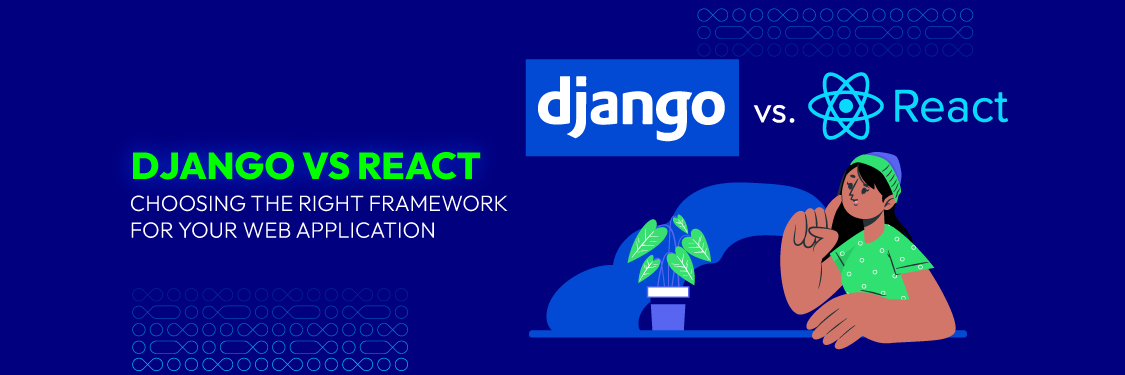Django vs React: Choosing the Right Framework For Your Web Application
Summer Nguyen | 05-07-2024

Frameworks are collections of software libraries that provide a range of functions, classes, and routines for constructing software applications. Therefore, choosing the appropriate framework is paramount for ensuring a project’s success.
Django and React stand out as the top frameworks in extensive use presently. React is a front-end framework. Meanwhile, Django is a full-stack framework.
By comparing their strengths, shortcomings, and suitability for a wide range of projects, this post provides you with the insights to decide which framework to choose between Django vs React.
Now, let’s explore the difference between these two frameworks to determine the best web development framework.
What is Django?
Django is an open-source web framework. It was written in the Python programming language. It is used to build complex web applications quickly and efficiently.

Python is a highly potent programming language, and Django is the corresponding framework designed for web development in Python. Developers also gain access to many functionalities, supported by Python’s security features.
Django provides modules that developers utilize to construct websites and applications directly from preexisting resources, eliminating the necessity of coding from the ground up.
What is React?
React is an open-source JavaScript library. It was developed and maintained by Facebook. It is also used to build dynamic and efficient user interfaces (UIs) for web applications.

Plus, React’s fundamental component-based architecture enables programmers to create reusable user interface components. This approach enhances code organization, and simplifies maintenance, making React a favored choice for front-end development.
Because React JS uses plain JS and a component-based approach, developers can learn it quickly. Unlike Django, React is a front-end framework focused on UI development. Developers rely on React’s JavaScript library to build UIs efficiently without starting from scratch.
Moreover, it has also been demonstrated that React libraries function as the client-side framework, managing UI, and sending data requests to the back end.
Django – Advantages and Disadvantages
Advantages of Django

Django is a Python web framework at a high level, offering multiple benefits for web development. Here are a few key benefits:
- Rapid development: Developers may instantly and efficiently create web apps with Django’s “batteries-included” approach, which uses a collection of components to handle common web development tasks.
- Flexibility: Django is scalable so it can expand with your application and withstand heavy traffic loads.
- Security: To keep your web application safe, Django comes with features that automatically block threats like SQL injection, cross-site scripting, and cross-site request forgery.
- ORM: The Django ORM makes interacting with databases simpler by automatically converting objects in your code to database data, eliminating the need for manual SQL queries. It generates tables for declared classes and dynamically adds rows during item construction.
- Ecosystem: With a sizable and vibrant community, Django offers copious amounts of documentation, tutorials, and third-party packages. This ecosystem promotes cooperation and provides answers to shared issues, which speeds up progress.
- Admin dashboard: It is a built-in interface that simplifies data management and administrative tasks for web applications.
- Restful APIs: The Django REST framework simplifies tasks by creating APIs for web applications.
- Testing support: Django’s integrated testing tools and framework ensure dependable, maintainable code development as well as application stability and quality through automated testing.
- Documentation: The Django framework provides excellent documentation and numerous free learning materials online like articles, tutorials, and video courses, making it easy for users to learn.
Disadvantages of Django
Despite being perfect for a lot of tasks, Django has certain drawbacks:
- Steep learning curve: Developers who have some experience with a programming language will probably pick up the framework more quickly than those who come from another language.
- Constant nature: Django might result in unnecessary complexity when projects don’t require all its features, potentially impacting performance and manageability, especially in larger projects.
- ORM overhead: Django’s integrated ORM may occasionally cause performance overhead, especially when conducting intricate searches or handling large datasets. To change performance, sophisticated optimization techniques could be required.
- Opinionated: Django’s rigid approach to web application development and structure may not always meet the needs or preferences of developers. This can be frustrating for those who prefer more flexibility in choosing frameworks.
- Version compatibility: it is only good for huge projects. Django contains substantial code to accommodate its various features. This poses challenges for low-bandwidth websites, as it necessitates server processing and time, even for basic functionality.
- Community size: The lack of diversity in Django’s active community may affect the availability of third-party packages, tutorials, and community support for specialized or niche use cases.
React – Advantages and Disadvantages

Advantages of React
Here are some of the key advantages of React JS you can leverage:
- Virtual DOM (Document Object Model): React uses a virtual DOM to enhance app performance by updating and rendering only the modified components instead of the entire page. This leads to quicker loading speeds and enhanced overall efficiency.
- Flexibility: React provides high flexibility and enhances efficiency in application development throughout the integration of JavaScript functions within components, leading to saving significant time.
- Control: React allows developers to efficiently manage multiple conditional statements within JSX, improving workflow by providing enhanced control over logic handling.
- Ecosystem: React provides tools like React Developer Tools, React Router, and Redux for debugging, routing, and state management. It’s clear syntax simplifies coding, and its declarative nature handles UI updates based on developer specifications.
- Reusable components: React.js uses a component-based architecture for easy component reuse across applications, simplifying UI development and enhancing code maintainability.
- SEO friendly: React.js supports server-side rendering, making application markup easily indexable by search engines, leading to better search rankings and visibility.
- Community support: React’s popularity has fostered a large, ensuring readily available assistance and easy hiring of skilled React developers.
- Compatibility: React is compatible with various frameworks, allowing rapid UI updates and versatile functionality. It integrates smoothly with UI frameworks like Bootstrap and libraries like Axios for API requests, as well as back-end frameworks like Express.js.
Disadvantages of React
Here are some drawbacks of React.js that you should know:
- Documentation: Since it updates so fast, there is not enough time for writing complete documentation. Therefore, it does not offer enough for guidance documentation and has difficulty in learning for new developers.
- JSX as a barrier: React uses JSX syntax, which may be unfamiliar to developers accustomed to traditional HTML templating.
- SEO: React is not appropriate for pages with frequently changing data. Due to the following factor:
- A single typo in JavaScript code can prevent indexing.
- Client-side rendering presents a challenge since Google bots receive either an inadequate amount of content or none at all, which makes it difficult for them to efficiently index.
- A crawling budget is the most pages that search engine bots can retrieve in a specific length of time (often five seconds for one script). SPAs have significant disadvantages when it comes to SEO. When the page has loaded, these web apps can supply content.
Important differences between Django vs React
Django and React are common frameworks used for creating scalable and maintainable online applications. Before delving deeper into each contrast, let’s first explore the table outlining the primary disparities between Django and React.
| Differences | Django | React |
|---|---|---|
| Language | Python | JavaScript library |
| Framework | open-source | component-based methodology |
| Working Style | Object-oriented methodology, as well as object-relational mapping | view-oriented and builds view layer applications |
| Database Support | ORM system, MySQL, Oracle | Async Storage, Realm, SQLite, PouchDB,… |
| Flexibility | batteries-included | trustworthy resources |
| Control | not offer API assistance | permit API integration |
| Community Support | vibrant community and documentation | large support community but it lacks documentation |
| Security | Requires careful management of dependencies | Offers built-in security features |
| Cost | Generally lower due to the open-source nature | This may involve higher initial setup and hosting costs |
| Scalability | Good for handling concurrent requests | Scales well with proper configuration |
Now, let’s explore the intricacies of the key distinctions between Django and React to help you make a decision.
Language
Django is a Python-based web framework building for complex database-driven websites and large projects that require vast knowledge.
React is a library for JS. Initially developed by Facebook, React.js is an open-source framework centered around components, designed to construct the view layer of applications.
Framework
On the one hand, Django is an open-source web framework that is versatile and has many improved features. Additionally, it supports the “batteries-included” approach. This web framework works great for massive projects and complex webs.
React, on the other hand, is a feature-light, quick, adaptable framework that adheres to component-based methodology. This web framework works best for small projects and simple websites.
Working Style
Django follows an object-oriented approach and supports fundamental technologies, templates, tools, and plugins. It also facilitates object-relational mapping and backs the Monolithic operational approach. It works best for applications that are complex and include multiple pages.
React is view-oriented and builds view layer applications using only plain JavaScript and a component-based architecture. Ideally, it helps control component instances and functions best for basic projects.
Database Support
Django framework supports all relational database management systems, including MySQL, Oracle, etc. React uses Async Storage, Realm, SQLite, PouchDB, and other databases for running operations.
Flexibility
Although the Django framework is adaptable and allows for cross-platform operation, it is challenging to modify individual modules. Compared to the React web framework, it is a little more challenging to learn.
The JavaScript library is flexible and makes use of trustworthy resources to facilitate the development process. It seems to be simple to operate and learn.
Control
The Django framework does not provide complete control over the functions as they have in-built libraries. It does not offer API assistance.
It appears that React is a library that offers more control over the JSX conditional statements and application development process. It permits API integration.
Community Support
Django has a strong support community and documentation. Instagram, Udemy, and Coursera are a few enterprises that trust Django.
Similarly, React has a large support community but it lacks documentation. A few companies that use React include Dropbox, Netflix, PayPal, Adobe, Microsoft, Yahoo, and Airbnb.
Django vs React: Which one is better?
The requirements of your project will determine whether you choose Django or React. Different tools excel at different tasks. If you have a project that needs to take advantage of both, you can stack them.

Choose Django, if
- You have experience with Python or you are interested in learning it.
- You want to seek strong community support and extensive documentation.
- You want to build powerful APIs with the REST framework
- You want to develop dynamic social networking websites
- You want to build web applications with ORM support, API backends,…
Or select React Js, when:
- You aim to construct dynamic web apps, single-page apps (SPAs), and immersive user interfaces.
- You want to build mobile applications using React Native.
- You want to develop games or real-time applications.
If you are unable to choose between the two, React and Django can be used together. The application’s performance can be enhanced by React’s virtual DOM, and Django’s integrated authorization and authentication tools can offer a reliable and safe back end.
Closing remarks
To sum up, React JS is the best UI library for quickly building interfaces due to its myriad benefits. These include improving user experience, optimizing performance, encouraging code reusability, and facilitating scalable and flexible development.
Moreover, its strong community support and SEO-friendly applications further establish React.js as a top choice in web development.
Even though we have been concentrating on React, we must acknowledge Django’s important contributions to the full stack of development. React vs Django is also a powerful combination that enables developers to design innovative web applications that push the limit of quality and innovation.






![Top 20+ Must-have Shopify Apps for 2025 [Free & Paid] - Mageplaza](https://cdn2.mageplaza.com/media/blog/must-have-shopify-apps/top-must-have-shopify-apps.png)
![[2025 Updates] Top 10+ Upsell Apps for Shopify - Mageplaza](https://cdn2.mageplaza.com/media/blog/best-upsell-shopify-app/cover.png)